In a tree just at the edge of the woods, just past our clothesline, not fifty feet from the house. I was in the cellar working on the table when Anne called me repeatedly, “There’s an osprey in a tree!” It’s a little early in the season for osprey; I wouldn’t expect them until the ice is out and they can catch fish, but there should be some around the lake. The bird sat still for several minutes. I looked out of the downstairs guest bedroom, which was the closest window in the house, and saw a mostly gray bird with a black and white face, plain gray tail. It didn’t really look like an osprey, but was about the right size for one. I thought, if it’s not an osprey, it’s a goshawk. When it turned and spread its wings to take off, I could see very faint red stripes on the breast. Anne looked up goshawk in the bird book and said, definitely. It was a super-close look at a bird that would have impressed even any non-birder. This was only the second one I’ve ever seen (except for things that I suspected were goshawks, but too far away to be sure), and the other was so far away that I only know it was one because I was with the Brookline Bird Club and people who knew and saw it closer had called it. Sorry, no picture, didn’t think of the camera until too late.
Seven Eights
We got a new piece in Koleinu tonight (well, when I started writing this, March 9), Vay’chulu by Karen Tarlow. That would be Genesis 2:1-3, “And the heavens and the earth were finished…”. The one word “vay’chulu” (ch as in German “ach”) is enough to identify the passage to moderately observant Jews; it’s the first paragraph of the prayers traditionally recited before Friday night dinner, the beginning of the sabbath. So I’ve sung the passage hundreds of times, but not to this tune. The cool part is that this new tune is in seven eights time. It takes a lot of getting used to.
The song in seven eights that we did last year (or two years ago? or both?), a modern Israeli song about spring coming, was counted 1,2,3, 1,2, 1,2 to a measure. This one is 1,2, 1,2, 1,2,3. The feeling is very different because the main and secondary accents are spaced differently. This one has that extra (compared to three fours time) beat at the end, so the measure has a little extra resting time. Carol said, “Just right for shabbos rest.”
Finished Object – Hat
I finished the hat I’ve been knitting. It’s really warm, though I won’t know that for absolutely certain until I try wearing it outdoors on a cold, windy day. The half-ribby hat I made last year is good most of the time, but two weeks ago it didn’t quite cut it in the wind.
This one has two layers over my ears, whereas the other has just one, and this one is heavier yarn to boot. I started with Bartlett Mills fisherman yarn, aran weight, for the outside of the cuff, and switched to the Jo Sharp Silk Road Aran Tweed wool-silk-cashmere blend (that I blithely picked up and took to the checkout counter without looking at the price! oof) for the inside. And wow is that soft! It doesn’t have great stitch definition, but I know the hat is cabled, and I don’t really care if that’s not obvious from a distance. I have lots of the Jo Sharp left over from two balls I bought (though I did get well into the second) and I’m a little sorry I didn’t make the whole thing out of it. I started with 108 stitches on number 7 needles, cast on with the Maine cast-on from um, is it Robin Hansen’s book Favorite Mittens. Because I haven’t started anything except those Fair Isle mittens in a while, and (oh no) I forgot how to cast on, and that was the only book I had handy with instructions for casting on. Of course, I could have looked at the internet, but I went for a book first.
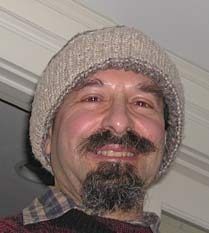
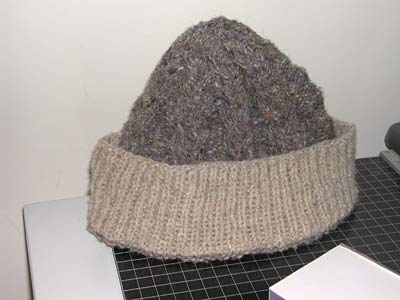
Light one tooth
I had a tooth extracted today, and I’m not my most cheerful. My periodontist has been after me for over two years to have this one out. He said (over and over) that there’s a lot of bone loss and that keeping it was endangering the next tooth over, sort of a domino theory of tooth loss. I thought he had said something like that about the one next to it, which he took out three or four years ago. In spite of that one coming out, this one was in bad shape.
I can date the other one by where I was working at the time. One of the things I was doing at the time was processing CDs of Chinese text — newspapers on CD, mostly — to get rid of markup and have real text left for the language modeling people at Dragon to work with. About half of computer speech recognition is acoustic modeling, what speech sounds like, which is what I was mostly doing. The other half is language modeling, what words are people likely to be saying, and what words are likely to follow which others. For instance, “abetting” is probably going to be preceded by “aiding and”. If the computer hears something that might be “a bedding”, but the words it just recognized before that were “aiding and”, that next one is “abetting”, even though that’s a much less common word than “bedding” (I’m guessing — since I don’t work there any more, I don’t have access to the word frequency tables). And how does a computer tell the difference between “to”, “too”, and “two”? By what came before it, and maybe what came after it. “Two many” is unlikely to be what you said.
Anyway, I was processing, as I was saying, Chinese text so we could count how many times each word and each pair of words occurred. One day when I was talking with the Chinese woman who was in charge of the project I said that my dentist said I should have a tooth taken out, and that I wouldn’t notice any difference in how I could chew (that’s not the case with the one that came out today — I need it to chew on that side). She said that was probably true; that sometimes people in China who are going to emigrate to the U.S. are told that dental care is very expensive here, and that it’s a good idea to have all their teeth taken out and get false teeth. I looked at her again and saw that she had beautiful straight even teeth. Hmm. Well anyway, that’s how I remember when the tooth that was behind this one came out.
Northern New England Spring Quiz
Just one question, for any readers in California, Texas, Kuala Lumpur, etc.
What’s going on here? This used to be a common late winter and early spring sight in Northern New England thirty years and longer ago:
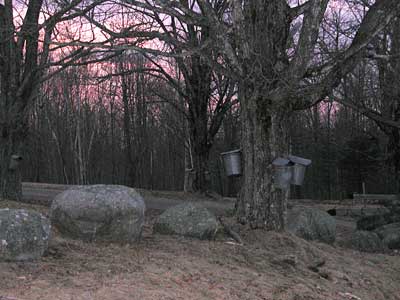
Those are sap buckets hanging on a sugar maple. Nowadays sugar makers mostly use plastic tubing to collect the sap rather than buckets, so you don’t see this so often. We were on our way back to Newton, heading south on North Raymond Road through Poland or Raymond, ME. We just getting to the only crossroad on that 8-mile stretch when Arlene said, “If you can, turn right and stop.” She’s been wanting a photo to draw a stamp from. It was about sunset. The camera protested that there wasn’t enough light to get a picture, but I was adamant.
When I was in college I used to see sap buckets like this on trees along US 7 between Williamstown and Bennington.
If you don’t know what happens between the tree and the pancake, try googling “maple sugar making”. Or check the Mass Maple – make your own site. Maple sugaring is a labor- and energy-intensive, but not tremendously complex, process. I’m just here to show you what I saw.
Table Progress
Maybe I haven’t said, but I’m building a table for the kitchen in Casco. It’s going to be a trestle table, I mean, rather than four legs, one in each corner, it’s going to have two things sort of like letter H on its side for legs, held together by a big board going through a slot in each one with wedges holding that board to the leg things. The vertical parts of the legs will be 5/4 pine, as will the top, and the parts on the floor and under the table top (what were the vertical parts of the H before it got turned on its side) are 2 x 4 inch pine (or, 1 1/2 x 3 1/2 by the time it’s done). I have yet to buy the wood for the top, because I know I have plenty to do with the legs first, and you don’t have to worry about dye lots with wood. The vertical parts of the legs are skinny trapezoids.
This was the first time I’ve made a diagonal cut with the taper cut gizmo on the ten-inch table saw, and it was not without some trepidation. The taper cut gizmo is two U-shaped aluminum extrusions that pivot together at one end and have a couple of wing nuts holding a slotted sheet metal arc that lets you set the angle between the two. One extrusion rides against the rip fence of the saw and the other has a little protrusion at the end to push the workpiece along. There’s a nice big handle on the part that goes along the fence. The trouble is, you have to hold the workpiece against the whole thing. You just have to remember that you’re not going to push farther than you can reach and you’re not going to reach across the saw blade. The saw cut through 5/4 pine as though it wasn’t there. I’m not sure how it would like cutting maple, but this project is working fine.
The legs are going to be three pieces of wood each, one big rectangle and two little right trapezoids, one on each side. Here they are cut, with the last cut edge of a trapezoid just having been planed.
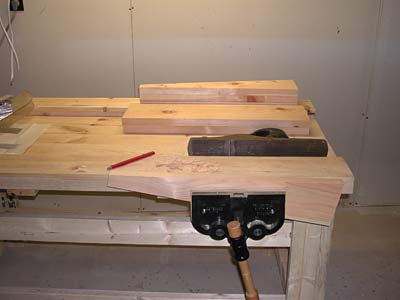
Um, it would be more picturesque with the plane standing on its base, so you could see it, I guess. Not gonna do it. Dulls the plane iron. Nobody who knows what they’re doing will rest a plane on its base.
Next step was to rout the ends of the rectangles down to 3/4 inch thick. When the trapezoids go on, the ends of the rectangles will be tenons that fit into yet-to-be-cut mortises in the horizontal bars. Here’s the state as of the end of Sunday:
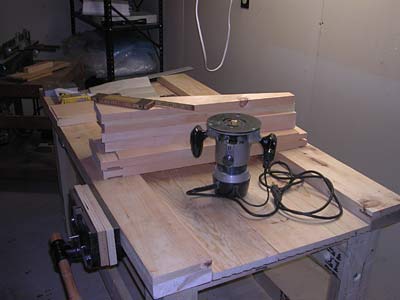
Something’s fishy on the left-hand end of the legs. The cuts don’t go all the way to the end of the board. That’s my mistake. When I figured the length of the legs, I thought 28″ high table top and cut the legs allowing for 1 1/4 inch tenons at each end and a little to spare, so I cut them to 28 inches long. I forgot to subtract the thickness of the table top. So I have most of an inch to cut off one end of each piece. Darn. I wasted four inches of board. Granted, that’s a scrap board, but even a scrap board is more likely to be useful if it’s four inches longer.
The next steps (not counting trimming the ends of the boards — that’s a routine step) involve a tool I got at Home Depot in Windham (because Lowe’s didn’t have any in stock when we were there getting the washer and dryer), a biscut joiner. I did my homework with internet reviews and settled on the DeWalt 682.
Biscuit joiners are by no means new, but they weren’t around when I was watching my dad do woodworking. I first saw them on a TV show, something like Yankee Workshop, probably over ten years ago. The idea is that a circular blade cuts a groove, a segment of a circle, out of the edge of two pieces of wood that you want to join. You glue a biscuit of wood, a precision-made chip shaped like a flat football, in the matching grooves.The biscuit makes a joint a little like a mortise and tenon to align the pieces of wood and provide more gluing surface than just the matching edges of the wood. It’s supposed to be a quick, strong, precise way to make wood joints. I’ll see how it works out in a week or two, whenever I can get back to the project.
Redpolls
We saw a half-dozen redpolls the weekend Millie and Joel were up in Maine with us, which must have been in mid-January. We hadn’t seen any since up until yesterday morning.
Redpolls are little brown-gray finches with a dark red spot on their forehead. They spend the summers in Canada and sometimes, but not always, show up where we live sometime in the winter. We’ve had them in Newton only a very few times. There were around thirty on and under our feeders in Casco yesterday.
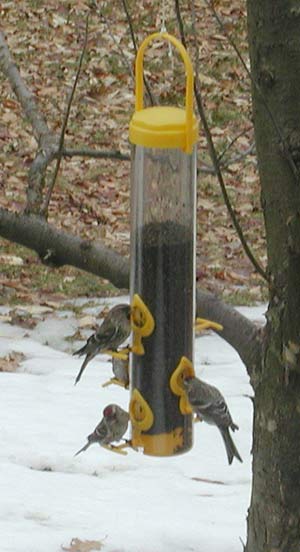
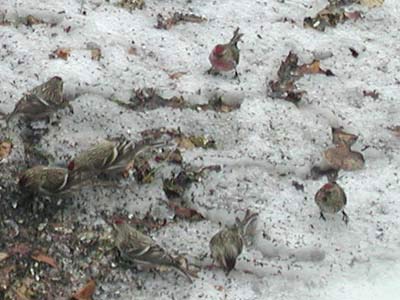
Laundry
The most significant part of this past weekend is that we got a washer and dryer in the house in Casco.
We’ve never had a dryer in Newton. The biggest factor is that we haven’t figured out how we’d vent it. Arlene likes line-dried clothes anyway. It’s fine in winter when the house is dry and things can dry indoors; and on good drying days the rest of the year. When the weather is humid for days on end, it’s a problem.
The previous owners in Casco had a washer and drier set up in an alcove in the bathroom. There was a 220 outlet and a vent for the drier, and water and drain connections in the back wall. Arlene has been wanting to get laundry appliances in there ever since before we bought the place so we don’t have to bring sheets and towels back and forth to wash. We’ve looked in Sears and Lowe’s before. Saturday evening we went to Lowe’s in Windham, looked at the appliances, asked the salesman what they had that was listed in Consumer Reports (though as usual, Consumer Reports rated appliances with slightly different model numbers from anything that we could find), and found that they could indeed deliver the next day if the items were in stock. So we just did it.
We gave them my cell phone number to call the next day to tell us when to expect the delivery. I guess the signal is marginal. The phone seems to work fine in the kitchen, but sitting on my bedside table it didn’t pick up a call in the morning. The delivery people showed up before 1 PM, though. They expertly took the bathroom door off its hinges to get the dryer in, hooked it all up, checked and told us there weren’t any leaks, and were done before 3.
We haven’t tried using the washer nor dryer yet. All in due time.
Farblonjet
We weren’t really, but it felt that way for a while, and it’s a great word to get a chance to say. My grandfather once said that word described a sheichet (kosher butcher) in Scarsdale. Or, in short, “lost”.
We took a walk around the block in Casco, which, as I’ve said, is a three mile walk, and decided to try to come back through the conservation land which we hoped abutted our property. Either it doesn’t really, or we need to find a trail through it that does come out to our boundary. In any event, we ran out of trail. We figured that if we kept heading downhill we’d eventually have to run into the road along the lake, so we weren’t too worried.
Going up the paved road from our house, we could look back down to the lake —
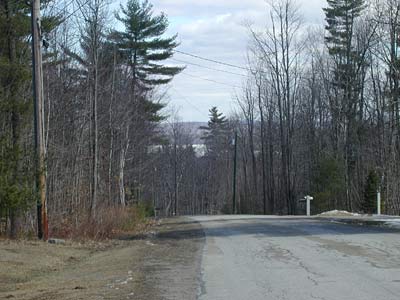
So far so good. Up on the main road, we noticed an absence of deer in this field —
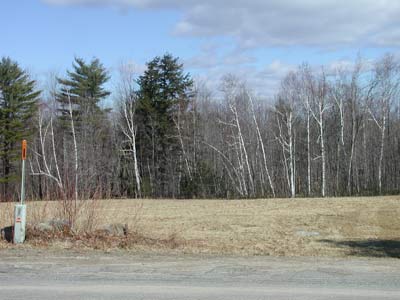
We’ve seen deer right there on two occasions, but it’s been more like 9:30 or 10:00 at night.
The second house on the right has a big barn and a curious window. It looks to me as though there was an extra double-hung window lying around when they put an addition on the house some long time ago, and it was too good to waste. I can’t imagine that the sash weights work when you put a window like this on a slant, but it gets some light in. We’ve seen several, or at least a couple of, windows like this in older country houses in Maine.
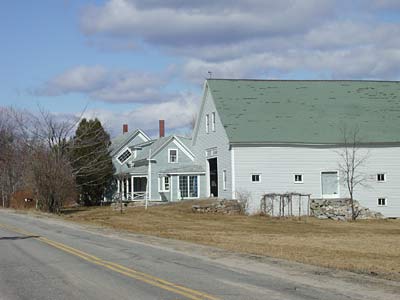
Another beautiful feature of this building is its big granite front step:
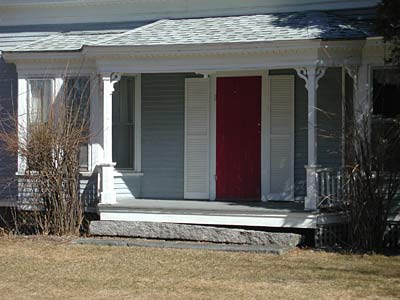
At this point you’re just about where you can see the White Mountains over Pleasant Lake.
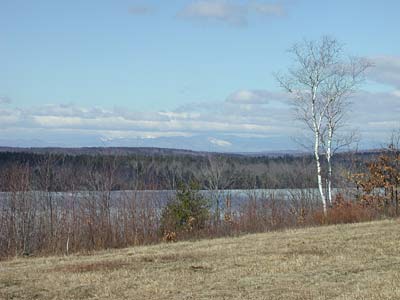
Back in November, or maybe it was still even October, there was one time when you could see snow on Mt. Washington (we thought) before we had been anywhere with snow on the ground.
A little farther along, back on the other side of the road, the conservation land abuts the edge of a field. We thought we’d check it out. The trail starts out as a very wide, clear trail, apparently once a road, with a stone wall on the left and a row of trees separating the trail from the field on the right. Looking back at the stone wall where another comes in at right angles to the trail —
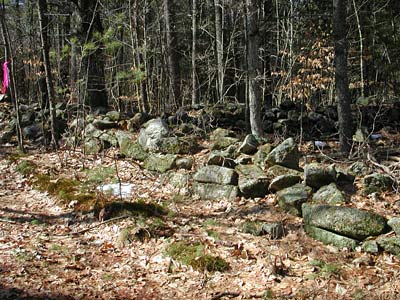
… and I had to catch up with Arlene after I paused to take the picture —
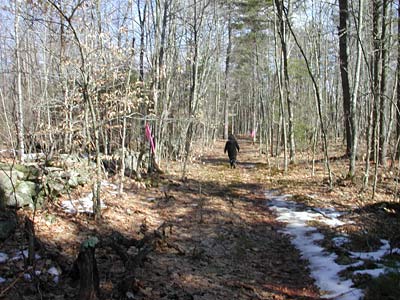
Somewhere along the way the main trail curved off to the right, leaving the stone wall for good. I thought the stone wall was going more or less the way we wanted to go, and that the trail to the right wasn’t going to get us closer to our place, so we followed a smaller trail in the same direction we had been heading. With the sun out we weren’t afraid of going in circles, and it just wasn’t that big an area to worry about getting lost in. We came to a tree that had steps nailed to the trunk and a platform at treehouse height, probably built as a tree stand by hunters. This tree —
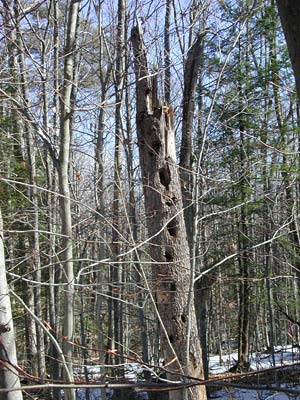
.. has been hacked up pretty well by pileated woodpeckers. Some of those holes are big enough to hold the end of a 2×4. We have trees like that on our property, too. We’ve only seen a pileated once up here, so far.
This gate was a little reassuring. At least other people had been in these woods before!

We kept going downhill in about the same direction. Eventually we could see something that looked like a building. It turned out to be a house along the road down to the lake, the little green house that had been for sale when we were looking but which we hadn’t really looked at. The lot adjacent to that, on the side we were coming from, is currently being built on. We breathed sighs of relief, squished through the muddy driveway out to the road, and walked on home.
Spring Birds
Arlene and I don’t wait for robins to show up. They’re not really signs of spring, anyway, around here. If you look, you can find robins all around the year in Massachusetts. That’s not to say they don’t go south for the winter. The ones that live here in the summer go south for the winter, and robins from Newfoundland come here for the winter. But anyway.
The chickadees and titmice have been sounding different the last few weeks, singing spring songs. But as for migrants, we saw one or two on Wednesday the 8th. Arlene came to meet me at lunchtime to walk around Cutler Park. We spotted a great blue heron in the cattails along the built-up side of the pond, trying to figure out how to handle a large fish it had caught. We were too far away from it to identify the fish, but it could have been a bass large enough for a human fisherman to keep legally. A little further around the pond we heard, then saw, one red winged blackbird singing in a tree over the water. That’s a bird that isn’t around in the winter. One of those two has to count as our first returning migrant bird of the spring.